Proof Of Afterlife By Memory
Theorem: If memory captures the entirety of the present moment, and the present moment is surrounding space, then memory contains unlimited space.
1. Is the Human Mind Analog or Digital?
1.1. Understanding the Distinction Between Analog versus Digital Recordings
Analog recording, like the old-school vinyl record, captures the essence of sound by imprinting it onto a physical medium. Through the vibration of a stylus, pressing into a soft surface, sound impulses become etched as a continuous groove spiraling towards the center. When played back, the stylus retraces its path along the groove, stirring vibrations that resurface the recording. It is a process rooted in the tactile evoking a sensory experience.

In contrast, digital recording translates sound into electrical impulses. Sound is converted into digital code, and saved in computer memory. The recorded becomes a sequence of numbers, devoid of physical form with the promise of preservation and easy replication. When this digital symphony is replayed, the numbers are summoned forth, converted back into electrical pulses, and amplified to playback the melodies they encapsulated.
The question, then, arises: Is the human mind analog or digital? Advocates of the analog liken its superior sound quality, suggesting a parallel between the rich tonality of vinyl records and the intricacies of our perception. The analog enthusiasts propose that, like the grooves on the vinyl, our minds possess similar hidden depths.
On the opposing side, proponents of digital recording, contend that the quality of a digital recording hinges solely on its resolution. They assert that enhancing this resolution can reach a sonic fidelity indistinguishable from the analog domain. In this view, the mind itself, with its capacity for processing information, could be seen as a digital recording device, flawlessly capturing the symphony of thoughts and emotions in digital precision.
Indeed, when one sets the stylus upon the grooves of a vinyl record, the passage of time leaves its indelible mark. With each gentle caress of the needle, the groove's fidelity wanes, bestowing upon the melody an unwitting patina of age, undeniably a transformation from the original vigor of sound. Yet, in digital recordings, such wear is an ephemeral notion, scarcely acknowledged. For as the sound is summoned from its numerical abode in memory, it remains steadfast and unchanged, preserved in pristine condition.
Consider this marvel: a digital recording, be it one year or a century old, bears no marks of wear, and its sound quality remains resolute and untarnished as the day it was born. The symphonies that reverberate through digital realms transcend time, poised to be savored with the same verve and splendor by the listeners of generations yet unborn. Such is the enchanting allure of memory - a digital recording's defining characteristic.
To ascertain whether the human mind dances to the rhythm of analog or the precision of digital, we embark upon a journey into the eye's retina. Within its depths, a mesmerizing arrangement of cells awaits our scrutiny, ready to divulge secrets of our perception. As we gaze upon the retina, we find a tapestry of light-sensitive photoreceptor cells - the rods and cones - that weave together to interpret our visual world. Their response to light is to translate this ethereal input into electrical impulses, igniting the neurons that form the foundation of our vision.
1.2. Analyzing the Eye's Retina: A Detailed Exploration
The retina of the human eye looks strikingly similar to the digital camera above. Let us take a closer look at a section inside the retina of the eye:
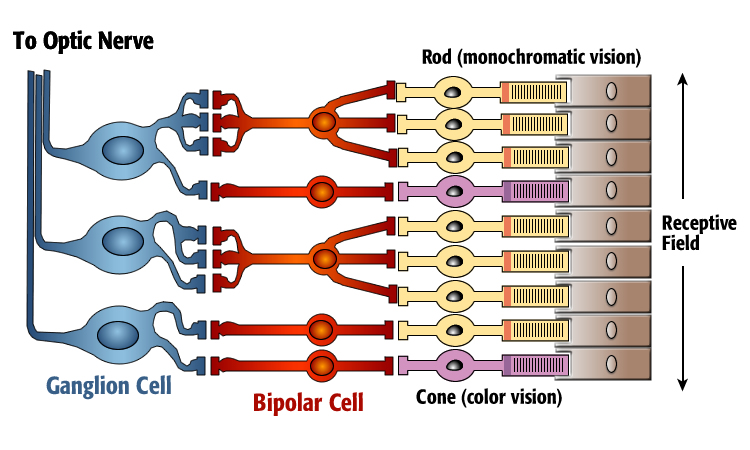
The receptive field shown above on the right, is where light hits the inside of our eye. Embedded in the receptive field are rod and cone cells. Rod cells (shown in yellow) detect monochromatic vision (black and white). Cone cells detect color. These nerves send impulses to the bipolar cells. There is some logic processing at the bipolar level. Then the output is sent to the ganglion cells where information is processed further. Then the data is sent out to the optic nerve to the brain as shown here.
In the retina light and color get converted into electrical impulses that are transmitted via nerves to the brain. This has the earmarks of a digital recording. What you see is light and color being converted into electrical impulses that are transmitted via wires to the brain.
1.3. Visualizing Our Field of Vision: A Diagram
The underlying structure of the eye shows that humans use digital recording techniques. The human mind appears to be digital. While the world may feel analog, the evidence shows differently. When you look closely at the retina of the eye it is apparent that human sight is digital. The illustration below shows a section of the retina, at the cell level, converting the environment into electrical data impulses:
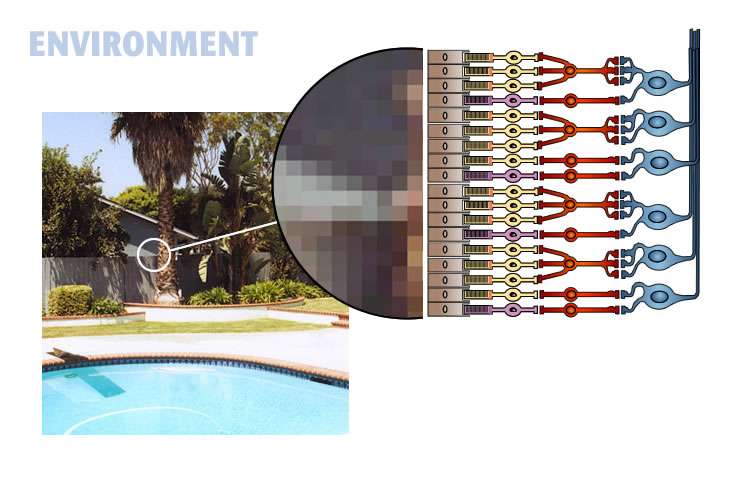
Imagine looking at your backyard pool. Your environment, upon close inspection, is made up of tiny dots or pixels as shown by the inset. Each square of color (in the inset) is one pixel. The color of that pixel is being picked up by cone and rod cells, processed digitally, and sent out the optical nerve to the brain. In the brain, this information is assembled into your environment inside the visual cortex.
1.4. Is Vision Digital? Exploring the Nature of Perception
This illustration shows how the human eye and brain work together to produce vision. Light comes into the eye through the cornea, then through the lens, and finally onto the retina. In the retina, light is converted to electrical impulses using nerves. The impulses from nerves are sent through the optic nerve into the lateral geniculate nucleus in the brain. From there they are sent to the visual cortex. It is in the visual cortex that the outside world is encountered.
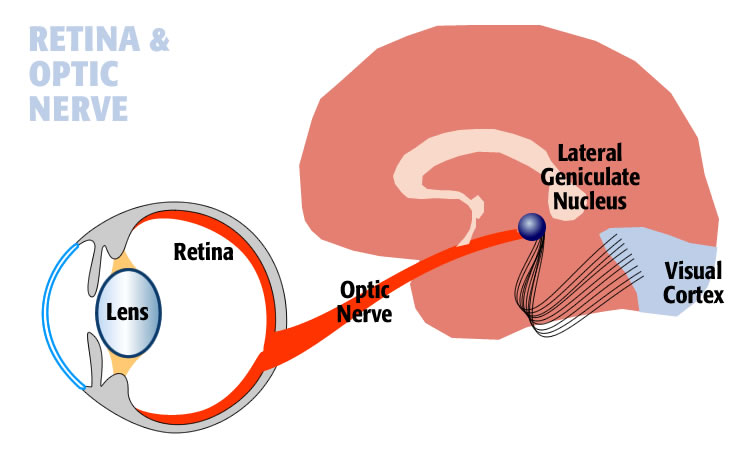
Note: We are using the example of perceiving the environment visually for clarity purposes. This does not imply that non-sighted people record any less information than sighted people. Nor does it mean that non-sighted people experience any less of the environment than sighted people. Non-sighted people experience the same richness of life as sighted people. They merely experience life differently. Their environment is complete in every way.
2. How the Mind Constructs the Surrounding Environment
2.1. How Vision is Processed in the Mind
This is a diagram of the steps required for the brain to perceive the outside world. Reality, as we perceive it, is a construct of the mind shaped by the interaction between sensory inputs, cognitive processes, and prior experiences. Our senses gather raw data from the environment, such as light, sound, and texture. This information is processed by the brain, which interprets and organizes it into a coherent representation of the world. It works as follows:
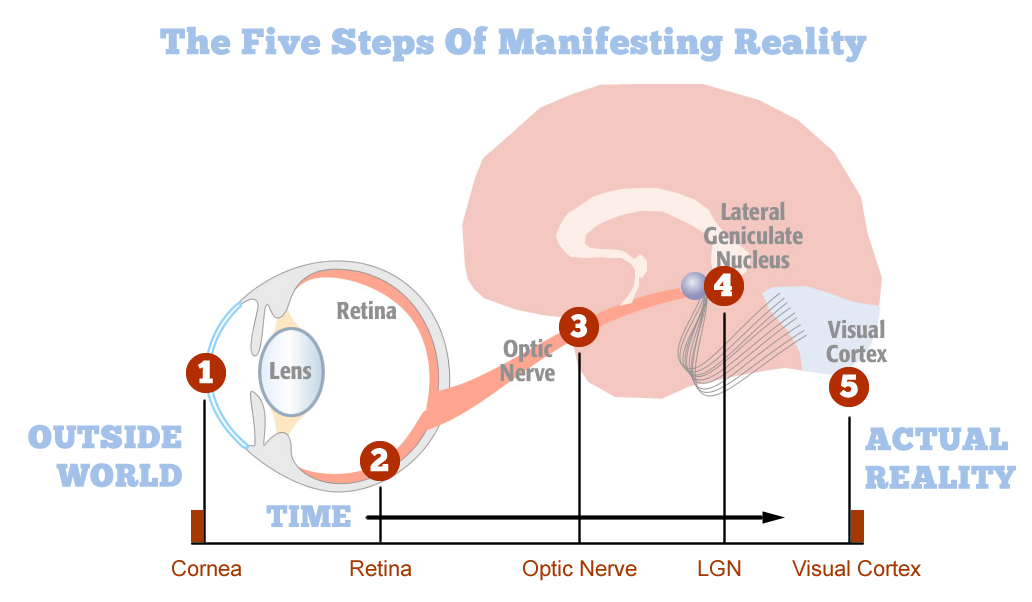
1. Light comes in from the environment.
2. It passes through the lens and strikes the retina at the back of the eye where it is converted into electrical impulses.
3. The electrical impulses are sent via the optic nerve to the brain.
4. They are received by the Lateral Geniculate Nucleus (LGN).
5. The electrical impulses are pre-processed and then sent by the Visual Cortex.
Cognition plays a key role, as the mind relies on memory, expectations, and cultural or personal frameworks to fill in gaps and make sense of incomplete or ambiguous data. This process is influenced by biases, emotions, and individual perspectives, meaning that each person's experience of reality is subjective and unique. In essence, reality is not simply "out there" but is actively constructed within the mind as an internal model of the external world.
2.2 How Is Reality Constructed in the Mind
Here is another view of how reality is assembled in the brain. On the far left are the rod and cone cells of the retina. They convert light to electrical impulses. These are sent over the optic nerve to the LGN. Then they are sent onto the visual cortex. Notice the outside world is perceived in the visual cortex. Everything to the left is outside the mind. Everything to the right is inside the mind.

The outside world is manifested in the visual cortex. The visual cortex is a part of the brain responsible for processing visual information. It is located in the occipital lobe at the back of the brain and plays a central role in how we perceive the world around us. The visual cortex is organized into multiple regions, each with specialized functions for interpreting different aspects of visual stimuli, such as shape, color, motion, and depth.
The primary visual cortex (V1) is the first area to receive visual input from the eyes via the thalamus. It processes basic features like edges, orientations, and contrasts. From V1, information is sent to secondary areas (V2, V3, and beyond), which perform increasingly complex analyses, integrating features to form coherent objects, recognize patterns, and interpret spatial relationships.
The visual cortex is also divided into two processing streams: the dorsal stream ("where" pathway) processes motion and spatial relationships, helping us locate objects in space, while the ventral stream ("what" pathway) focuses on object identification, including color and shape recognition. Together, these pathways allow the brain to construct a detailed and dynamic representation of the visual world.
2.3. The Mind and its Environment: The Traditional Perspective
Here is an image of the human mind. The human mind is represented by the tiny red dot, in the head of one of the people in the group. That person's environment is represented by the large cube surrounding the scene. Imagine the group is standing in a large auditorium. In this view, the mind is a small dot surrounded by a large environment.
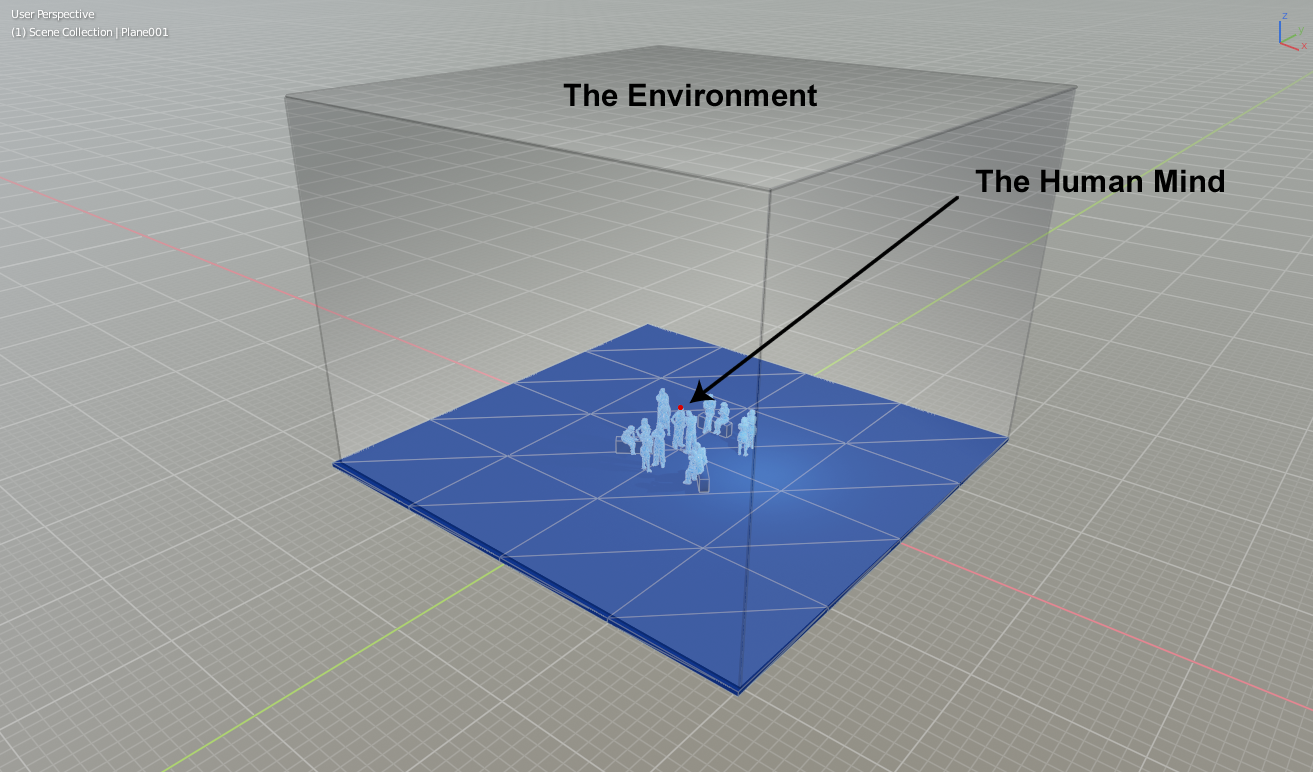
This view is normally what most people envision in terms of the mind versus the environment. We envision the mind as the grey matter inside our head (shown as a red dot). We envision the environment as our surrounding space (shown as the surrounding cube). This is what most people believe is the relationship between the mind and the environment. They see the mind surrounded by a large outside world.
However, we will recall from Section Three above, that the environment is assembled and perceived inside the visual cortex. Put another way, reality is not realized until it is assembled inside the visual cortex. That means the surrounding environment is actually inside the mind. We will show what that looks like next.
2.4. The Mind and its Environment: A New Perspective
Here is the afterlife enlightened view of the mind versus reality. Reality is realized inside the mind. You can see from this illustration that the mind extends out into the surrounding space as shown.
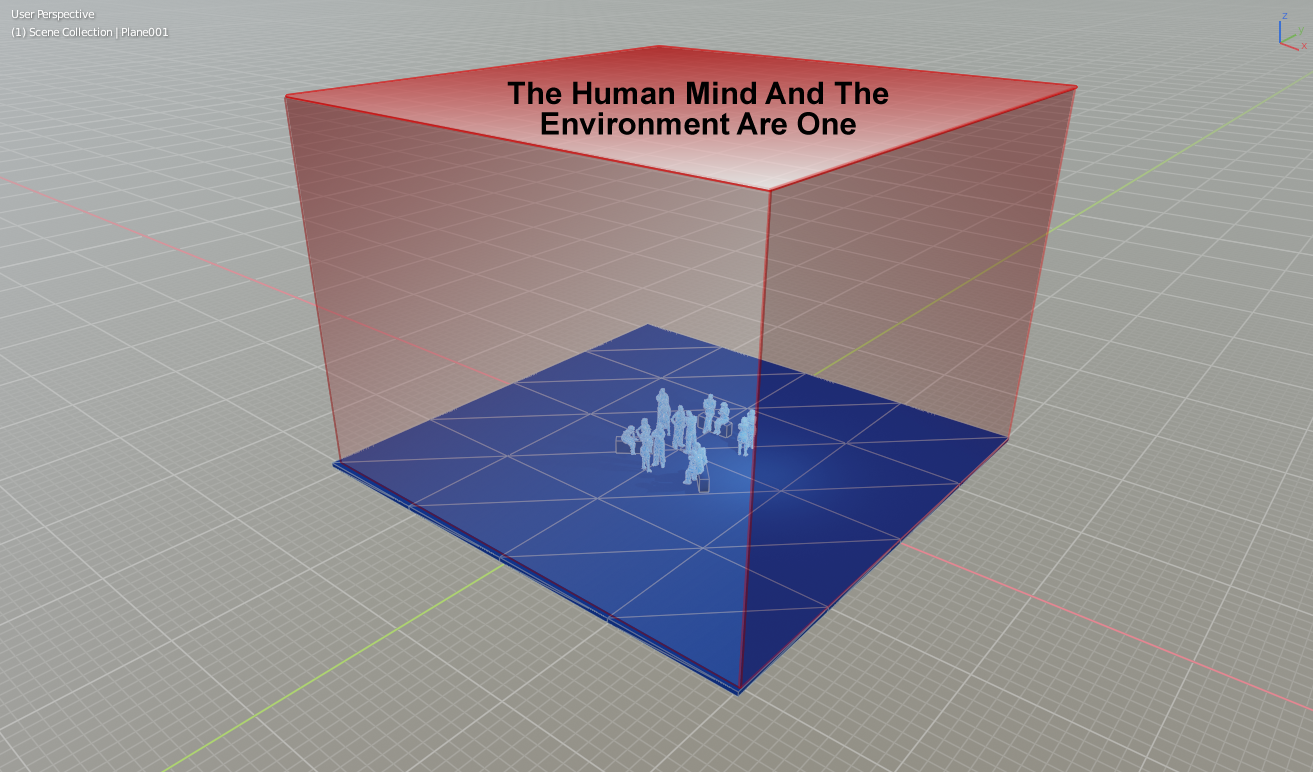
The concept of surrounding space being "inside" the visual cortex refers to the brain's ability to construct a mental representation of the external world within its neural networks. When we look around, the spatial layout we perceive - objects, distances, and their positions relative to us - is not "out there" in the same form but is recreated as a dynamic model inside the visual cortex and related brain areas.
This process begins with light entering the eyes and being converted into electrical signals that travel to the brain. The visual cortex interprets these signals to construct a detailed spatial map. As information flows through the dorsal stream (the "where" pathway), the brain analyzes spatial relationships and motion, enabling us to perceive the position and movement of objects in our surroundings. This neural activity creates an internal manifestation of space that aligns with the external world, allowing us to interact with it effectively.
In essence, the "space" we perceive exists in the mind. The brain integrates sensory input with prior knowledge, constructing a 3D representation of the environment entirely within itself. So, while the surrounding space feels external and expansive, it is an internal mental model housed within the visual cortex.
3. Analyzing the Visual Cortex: A Detailed Exploration
3.1. Understanding the Inner Workings of the Visual Cortex
The electrical impulses coming into the mind through the eyes, ears, and other senses are not of sufficient resolution to create the vast detailed world around us. If our exterior world was just a stream of impulses coming from the rods and cones of the retina it would be grainy, blurry, and flat. To create the fully integrated, three-dimensional world that surrounds us the mind takes the data from the outside and recreates it into a three-dimensional model of the world. The world as we experience is built within the Visual Cortex. This is where outside reality is realized.
The process the mind uses to create our world is called modeling. Modeling is the building of a three-dimensional model of the environment. This is the only way our world can be created using the limited information it has to work with. Modeling is done using three-dimensional modeling software like Blender. When you first open the software, you have an empty three-dimensional world. Modeling is the process of adding objects into this world, eventually creating a fully detailed three-dimensional environment filled with objects, textures, and colors. The Visual Cortex does this on the fly, meaning it creates the three-dimensional model of reality as fast as it is presented.
3.2. Exploring Three-Dimensional Modeling Within the Visual Cortex
This is a detailed look at the processing taking place within the Visual Cortex and its associated structures. The Visual Cortex is not just a pass-through of visual data. There is heavy processing that takes place. It builds our three-dimensional world, filling in the blanks in data to create a complete, unbroken, and resolution-independent surrounding environment.
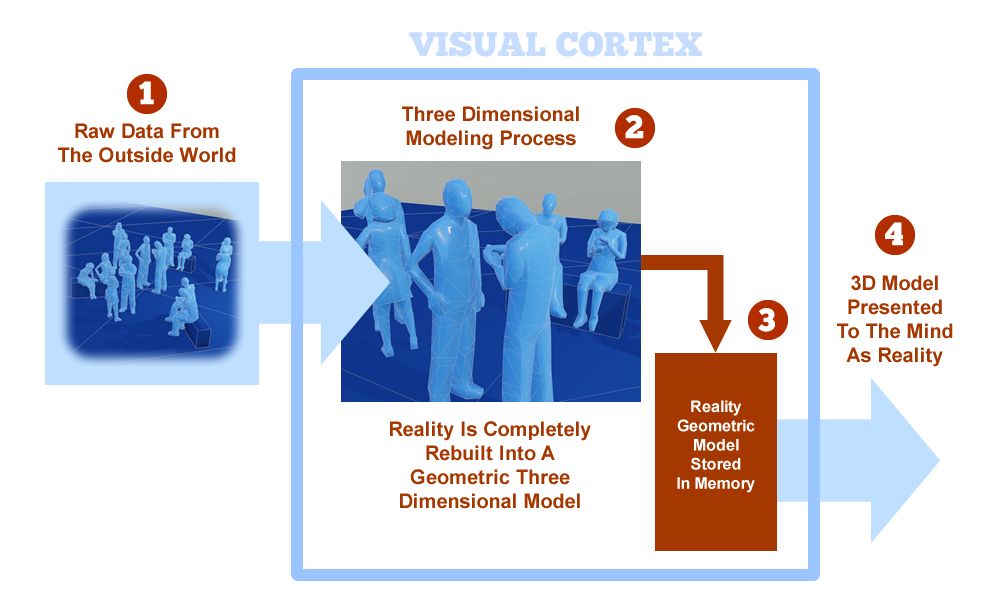
Here is the processes taking place:
1) Raw electrical impulse data comes into the visual cortex through the senses.
2) Once inside the visual cortex, a three-dimensional modeling process takes place. This is similar to the computer modeling process that takes place when a graphic artist creates an environment for a video game. The Visual Cortex creates a geometric model of our surrounding environment as it unfolds before us.
3) The three-dimensional model is moved into memory as a file in a computer. This model is resolution-independent, meaning it will remain sharp and clear no matter how close we look at it. It is always complete and detailed in every way.
4) The three-dimensional model of the world created in the Visual Cortex is presented to the mind as reality. It is here, in step 4, where we experience reality. This is not a copy of reality. This is our reality.
3.3. Gaining Insight into How We Experience Reality
Below is a more complete view of visual processing. Notice how we have introduced a virtual reality headset into the diagram. A virtual reality headset is a fully three-dimensional projector. It is used to project three-dimensional models into three-dimensional surrounding space. A carefully crafted three-dimensional model, viewed through a virtual reality headset, is indistinguishable from "real" reality.
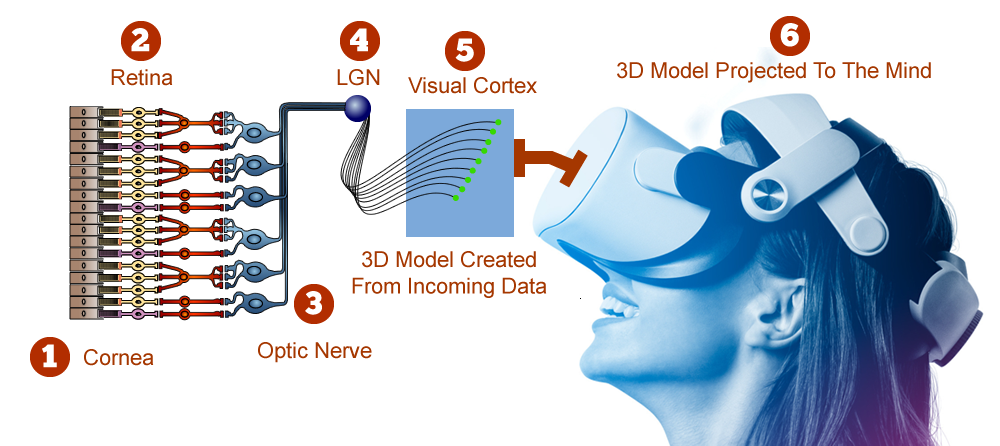
Here is a true picture of how the mind uses the visual cortex to experience three-dimensional surrounding space:
1) Light comes in through the lens of the eye.
2) Light strikes the retina where it is converted into electrical impulses.
3) Electrical impulses are sent through the optic nerve to the mind.
4) They arrive in the LGN where they are preprocessed and sent to the Visual Cortex.
5) Inside the Visual Cortex the incoming electrical impulses are used to build a fully three-dimensional model of the outside world using a process called modeling.
6) The geometric three-dimensional model is sent to the virtual reality headset where it is projected as your three-dimensional environment.
We experience reality in the visual cortex, not in the outside world.
3.4. The Concept of the Mind as Space
The concept of the mind as space via the visual cortex highlights how the brain constructs an internal representation of the external world. The visual cortex, located in the occipital lobe, processes raw sensory input from the eyes and organizes it into a coherent spatial model. This begins in the primary visual cortex (V1), where information about edges, contrasts, and orientations is mapped in a retinotopic layout that reflects the structure of the visual field.
As visual data flows to higher-order areas, such as V2 and V3, and through the dorsal ("where") and ventral ("what") streams, the brain integrates depth, motion, and object relationships. This integration creates a three-dimensional spatial understanding of the environment, enabling us to perceive and interact with it. Importantly, this internal space is not a direct mirror of the external world but a construct shaped by sensory input, memory, and expectations.
Through the visual cortex, the mind transforms physical space into a mental arena where perception, navigation, and even imagination occur. When we visualize distant locations or recall spatial memories, the same cortical mechanisms activate, extending the mind's spatial capabilities beyond immediate sensory input. This reveals the mind itself as a dynamic space that encompasses both perception and creativity, blurring the line between internal and external realities.
3.5. Where Is the Evidence for the Mind as Space?
If the mind is space as you suggest, then where is the proof? Fortunately, there is proof of the mind as space and it is not that hard to find. We can find proof of the mind as space in a phenomenon called Out-of-Body Experience or OBE. OBE is where you suddenly find yourself outside your body. It is for this reason that we have included a section on OBE. OBE is physical, irrefutable evidence of the mind as space.
Medical science is baffled by this. They don't believe your conscious awareness can be outside the body. However, about 10 percent of the population has experienced looking at their body from outside their body. Millions of reports of this are strikingly similar. Medical science may be baffled but Proof of Afterlife is not. People find their consciousness outside the body because the mind is space.
If you ever find yourself outside your body, you'll know it is true. Finding yourself outside your body is proof that the mind is space. You can find that while you may be outside your body, you are still inside your mind.
4. Understanding How Memory Absorbs Reality
4.1. Storing the Current Environment into Memory
Imagine standing in this backyard looking at this garden as shown below. This is your surrounding environment. Shown here is what you see. The sun is shining. It is a nice day. You are enjoying the view. You can hear the birds chirping and kids playing.
The clock strikes 12:00 noon exactly.
The pixels in our eyes act like the camera CCD and capture the scene. The camera uses a capture program to take the matrix from the CCD into memory. Our eyes take in the pixel matrix of the environment and pass it to the visual cortex of our brain. In the visual cortex reality is assembled. This is the point in time where we experience the present moment. From there the present moment gets absorbed into memory.
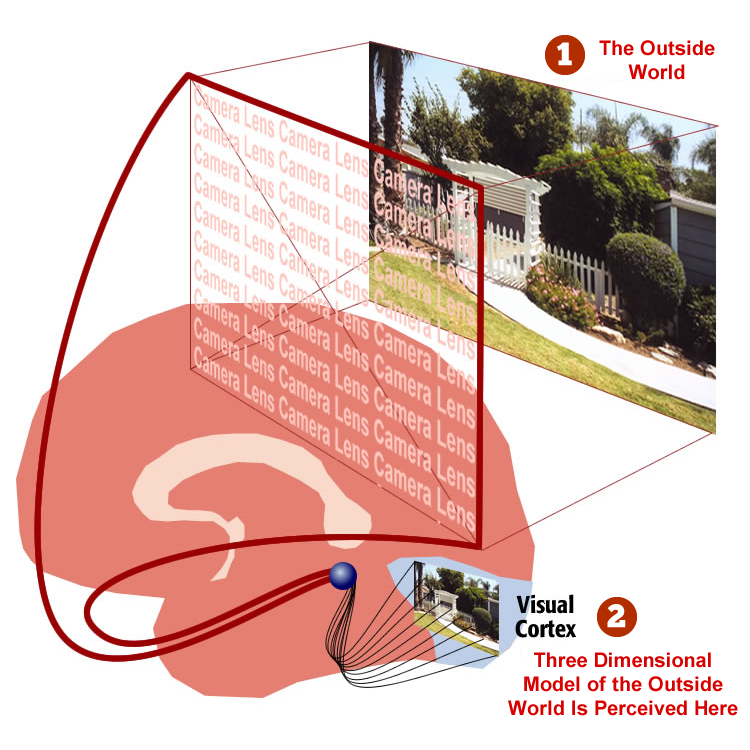
A digital camera takes a picture when you press the button. It is a one-time event. Human memory is capturing reality continuously like a digital video camera. It is taking pictures of reality continuously like a movie. In the section above we looked at one specific moment - at the pool at noon. The environment was captured and loaded into memory. However, that was just one moment. Now we want to look at the next moment because we have a brand new environment.
4.2. Archiving Past Realities Over Time
As we move through time, from environment to environment, moments get captured in the visual cortex, assembled into three-dimensional models where they are absorbed into memory. As reality unfolds before us, we create three-dimensional reality and store it in memory as shown here:
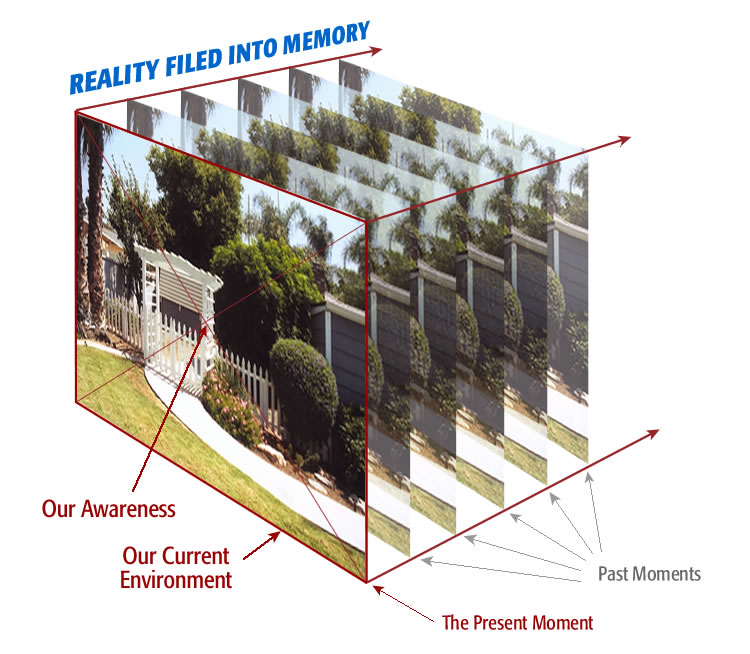
The frame on the left represents our present three-dimensional reality. This is our current reality. It is physically located in the visual cortex. The horizontal line moving back (with arrows) to the right represents past realities that have been filed into memory. Awareness exists at the center of the leftmost current environment. Awareness stays in the present. Realities move progressively back and to the right as they get filed away in memory. Think of these past realities as frames as being filed into memory. The frames of the past move to the right. As time moves, memory absorbs new environments. The dimmed slices represent former present moments that have been filed away into memory.
4.3. Exploring How Memory Absorbs Unfolding Reality
As realities stack into memory, awareness remains in the present moment. Awareness stays in the present. This is our point of view throughout life. This illustration shows past realities stacking into memory like frames of a video. Each frame represents a full three-dimensional environment.
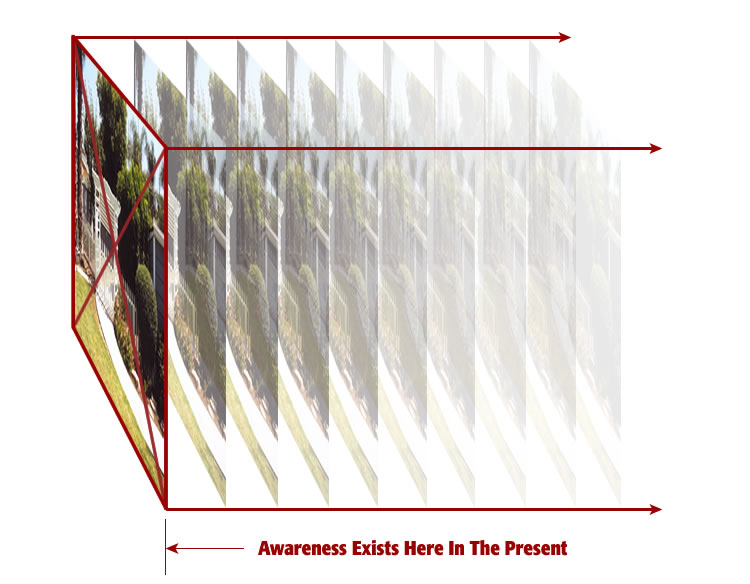
Reality (the environment around us now) is the present. It is where we are. It is vivid. The further we get away from reality the more memory appears to fade. This illustration above shows reality at 100 percent opacity, frame 2 at 50 percent opacity, and frame 3 at 40 percent opacity. This is intended to signify how memories fade as we get further away from them in time. In reality, moments of the past and the moment of the present are identical in quality. It is only our position in time that makes past realities seem to be less vivid. Memories of past moments are a perfect bit-for-bit and fully detailed, just like the reality of the present. Its memory did not fade over time. When you accept this assumption everything comes into focus. In the digital world, the concept of copy does not apply. Copy is an analog concept. In the digital world, the original and copy are identical. The duplicate is precisely the same as the original in every way. A copy connotes diminishment in the analog world. In the digital world, it is a pristine original.
4.4. The Profound Nature of Absorbing Space into Memory
What could be larger than the space you are standing within? There is nothing larger than your surrounding space. It is unlimited in all directions.
Yet that unlimited three-dimensional space you are living within gets absorbed in total into memory. The entire space gets absorbed into memory as soon as you see it. If your surrounding space is unlimited in all directions, and it just got absorbed into memory, what does that say about memory? What does that say about the size of memory as compared to the outside world? The outside world, with all its enormity, fits inside memory.
4.5.The Present Moment: Leading Edge of Time-Space Continuum
Memory is physically large. In terms of the present moment, it is a three-dimensional space. In terms of time, it is a time-space continuum. The present moment, in all its physical size, is merely the leading edge of a vast time-space continuum. Visually memory looks like this:
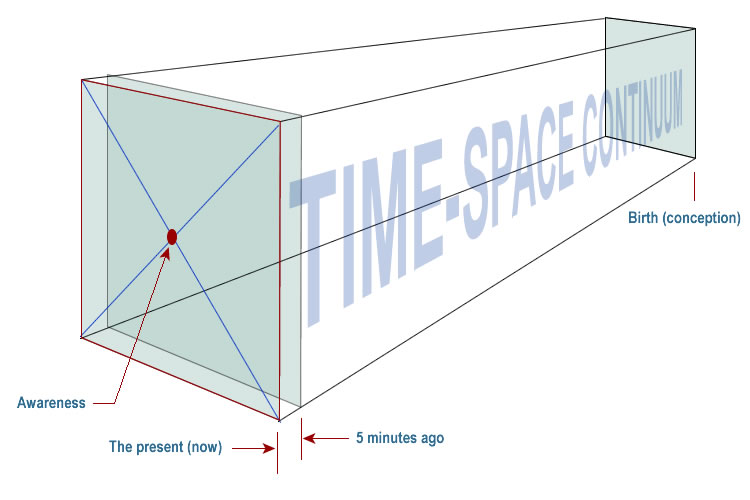
The present moment is the only moment we experience first-hand during life. The present moment goes into memory as a digital original and remains that way. Our awareness moves forward in time. That displacement in time makes it impossible to experience past moments first-hand. That perception of a moment becoming old is just that - a perception. That former moment is in memory; intact, exactly bit-for-bit as it was when we experienced it. All that is required for that moment to be experienced first-hand again is for us to move our position in time. Because everything is in memory it is possible, but not now during life. We have to wait until the end of life for that to happen.
5. Understanding the Relationship: Awareness and Memory
5.1. Absorbing the Present Environment into Memory
As we move through life awareness stays in the present. Our model of a human computer, consisting of memory space and awareness, is shown here:
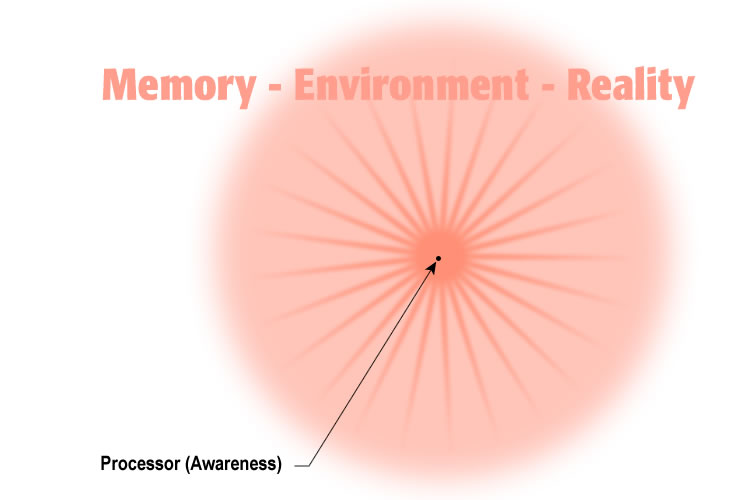
The processor is shown by the black dot at the center of the environment. The processor operates from a fixed location within memory space. The surrounding memory space is the processor's environment. The human mind is made up of awareness, as represented by the processor, and the environment, as represented by accessible memory.
5.2. Memory Encompasses All Realities: Past and Present
As each moment passes, it moves from being experienced in the present into the past. First, the moment is experienced as the present. Then it gets absorbed into memory as a moment of the past.
You can think of this as the present moment being filed away into memory intact. The human experience has depth in time. We will not experience it until the afterlife, but our entire history is in memory all the time.
The illustration below shows this happening. This shows how reality gets absorbed into memory. Reality is absorbed in its entirety. Every detail of the environment gets absorbed and filed into memory. We do not notice this happening. It happens automatically in the background. The environment around us is already in memory when we experience it. As you experience the outside world, it is absorbed into memory. The act of experiencing a moment and absorbing it into memory is the same thing as shown here:
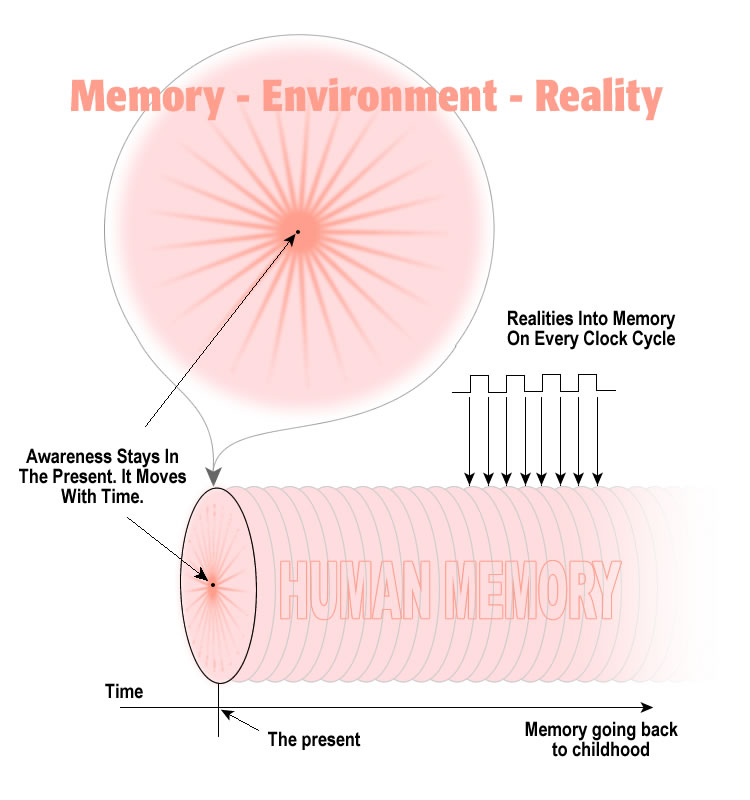
Each reality is filed away in memory on each beat of the clock. There is no evidence that memories of past moments are thrown away by the mind. On the contrary, the overwhelming evidence is that memories of the past are retained by the mind. The fact that you cannot remember a moment of the past as you experienced it the first time does not invalidate this concept. It merely means that you are unable to remember it at this time. Elderly people can recall in great detail moments that occurred 50, 60, or even 70 years ago. Does this mean that the mind retains certain memories and discards others?
No, memory discards nothing. The mind retains all memories intact. Human memory is all-consuming. Like a computer, we retain information absorbed into memory. A computer does not discard information in memory. Likewise, human memory does not discard information either. Humans retain experiences. All of them. Nothing is discarded. Everything is in memory all the time.
Reality is being filed in memory as we move through time. As we move forward in time, the next reality is being filed as we go. This is not a recording of reality. It is reality. It is intact as we experienced it first-hand. Experiencing reality is filing it away in memory. We experience only the front edge of a time-space continuum that exists within everyone.
5.3. In Afterlife, Awareness Expands Throughout Memory
As we approach the end of life we have everything in memory. We have every moment in memory exactly as it was when we experienced it the first time. It is space, not flat like a movie. This is the potential we carry with us as we move through life. This is the potential we have with us at our last moment of life.
At the last moment of life, awareness undergoes dimensional change. It goes from position in time to all of time. It goes from position in space to all of space. This transition happens in an instant. Awareness did this by expanding into the accumulated memories that we gathered throughout our lifetime. Memory contains everything you have ever experienced. It has absorbed the three-dimensional space of every moment as you experienced it. It has retained all moments. At the end of life, all memories are experienced simultaneously. At that precise moment, we become aware of all our memories at once.
5.4. Conclusion: Memory, Awareness, and the Mind as Space
The idea that awareness undergoes a profound dimensional transformation at the last moment of life is poetic. It suggests that our perception of reality - ordinarily constrained by the sequential nature of time and the localized nature of space - expands into an all-encompassing experience that transcends these limitations. Let us unpack this concept about memory, awareness, and the mind as space.
Awareness Expanding Beyond Time and Space
In ordinary life, awareness is confined to specific points in time and space. We experience the present moment as a linear progression from the past, moving forward into the future. Spatially, our perception is centered on our physical location, with our senses defining the immediate world around us. However, at the moment of death, this framework inverts, allowing awareness to access the entirety of accumulated experience - all moments and spaces - simultaneously.
This transition is likened to the unfolding of a higher-dimensional perspective. Awareness expands to encompass the full span of one's life, no longer bound by the "now" but instead perceiving all "nows" at once. Similarly, spatial boundaries dissolve as the mind revisits every space ever experienced, merging them into a unified mental "space."
Memory as the Repository of Experience
Central to this transformation is memory. Throughout life, memory acts as a repository for the spatial and temporal dimensions of every experience. Each moment, as it unfolds, is encoded within the mind, retaining not only its events but also the spatial and sensory contexts in which it occurred. In this sense, memory can be seen as a cumulative model of all the spaces and times we have inhabited, a mental universe that encompasses the external world.
At the end of life, as awareness expands into the totality of memory, these stored moments may be revisited simultaneously. This suggests that memory is not just a static archive but a dynamic framework that holds the multidimensional imprint of our existence. In accessing all memories at once, the individual transcends the sequential nature of time and the localized perception of space, experiencing afterlife as a holistic continuum.
The Mind as a Multidimensional Space
This perspective aligns with the idea of the mind as space, particularly in the visual cortex and associated brain regions. The visual cortex constructs our perception of three-dimensional space and organizes the sequence of visual experiences into a coherent model. Similarly, memory integrates these spatial constructs with time, creating a comprehensive map of our lived experience.
At the moment of death, this mental space becomes fully realized. The boundaries between past and present dissolve, and the mind's spatial model - built throughout a lifetime - expands to encompass every place, moment, and sensation ever experienced. This transforms the mind into an infinite space, one that is no longer constrained by the limitations of physical reality.
Simultaneous Awareness of All Memories
The notion of experiencing all memories simultaneously is profound. It implies a dissolving of the distinctions that normally separate moments and events. In this state, the individual will not perceive memories as isolated fragments but as an interconnected whole, where the significance of each moment is understood about the entirety of one's existence. This could lead to a profound sense of unity and understanding, a life "review" that transcends judgment or linear narrative.
Such a state is not merely about recollection but about immersion in the totality of one's being. It may feel timeless, as every moment is equally present, and boundless, as every space ever inhabited merges into a single, infinite mental construct.
Reflections on Consciousness and Transition
This description of the end-of-life experience invites deep reflection on the nature of consciousness. It suggests that awareness is not inherently bound to time and space but operates within these dimensions during life for practical reasons. At the moment of death, when the constraints of physical existence fall away, awareness reverts to its true, expansive nature.
Whether viewed as a neurological process, a metaphysical transition, or a spiritual awakening, this perspective underscores the richness and complexity of human consciousness. It proposes that the mind's capacity for memory and spatial representation is far greater than we typically realize, capable of encompassing the totality of a life in a single instant.
Conclusion
The idea that awareness undergoes a dimensional transformation at the end of life reveals a profound interplay between memory, time, space, and consciousness. By expanding into the entirety of our accumulated memories, the mind transcends its ordinary constraints, experiencing life as an infinite, simultaneous whole. This perspective not only deepens our understanding of memory but also offers a vision of human consciousness that is vast, interconnected, and timeless. In terms of afterlife, the mind is not just a passive observer of reality but an active creator of a multidimensional space, culminating in a moment of ultimate awareness.
-- This Concludes Proof Of Afterlife By Memory --